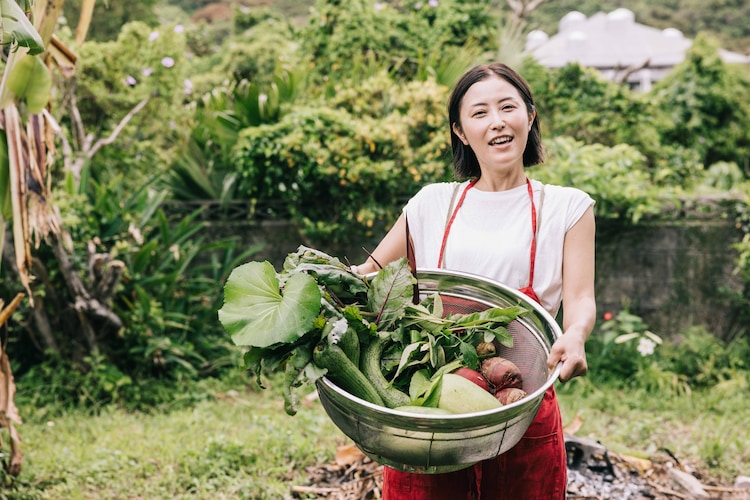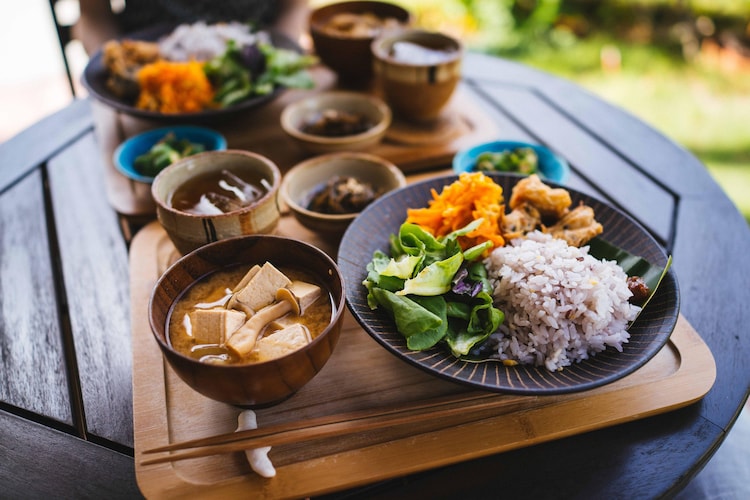What does an Okinawa diet look like compared to an Indian diet?
From Japan to your plate, the Okinawa diet can be easily adapted for Indians by incorporating the same principles. Experts are here to guide you.
In short
- The Okinawa diet emphasizes the consumption of vegetables, whole grains, soy products, and moderate amounts of fish
- It has many health benefits
- However, this diet may not be suitable for everyone
If you’re a Reels fan, you’ve probably heard about Japan’s futuristic innovations, with reports claiming the country is already living in 2050. From fancy vending machines and self-heating take-out meals to advanced public toilets, Japan continues to impress with its cutting-edge technology. And let’s not forget J-Beauty, which is revolutionizing the skincare industry.
Apart from impressing everyone with its progress, Japan is also offering valuable lessons about healthy lifestyle, where the Okinawa diet is becoming widely popular.
But can this diet be modified for Indian food? Let’s ask the experts.
What is this?
Talking about the origin of the Okinawa diet, Anshul Singh, Team Leader, Clinical Nutrition and Dietetics, Artemis Hospitals, Gurugram, said, “It originated from Okinawa, Japan, a region that has one of the highest life expectancy rates in the world.”
This diet is primarily plant-based, including vegetables, whole grains, soy products, and moderate amounts of fish.
“It became popular because of its association with longevity and low rates of chronic diseases among Okinawans. This diet, focused on nutrient-rich, low-calorie foods with high antioxidant content, has gained global attention, especially among those interested in healthy aging and disease prevention,” says Singh.
The Okinawa diet’s simplicity and emphasis on whole foods make it an excellent choice for those looking to improve their overall health.
Furthermore, Esanka Wahi, nutritionist and founder of Eat Clean with Esanka, explains that there are two versions of the Okinawa diet: traditional and modern.
- CarbohydratesThe traditional Okinawan diet is high in carbohydrates, especially from sweet potatoes, which make up a large portion of the calories. In contrast, the modern diet has seen an increase in refined carbohydrates and a decrease in sweet potato consumption.
- ProteinTraditionally, protein was derived from plant sources such as tofu and small amounts of fish. Modern diets include more animal proteins, including pork.
- FatThe traditional diet is low in fat, mainly from plant sources such as soy and a small amount of fish oil. Modern adaptations have seen an increase in saturated fat, especially from meat and processed foods.

what to eat?
Staple foods in the Okinawa diet include sweet potatoes, bitter gourd (goya), seaweed, tofu, and miso (fermented soybeans).
The diet includes a variety of green and yellow vegetables, whole grains such as rice and millet, and moderate amounts of fish, particularly those rich in omega-3 fatty acids. Pork is also sometimes eaten, often in small quantities.
However, certain foods should be avoided, such as processed foods, refined sugars, and excessive amounts of meat and dairy products.
Know the benefits
Priyanka Pranay Bandal, senior dietitian at Manipal Hospital, Pune, says, “The population of Okinawa is known for its longevity, so the most obvious benefit of this diet is that it increases longevity. The emphasis on nutrient-rich foods promotes cardiovascular health and also significantly reduces the risk of heart disease.”
Meanwhile, many people adopt the Okinawa Diet for weight loss because it is low in calories and high in fiber. This diet encourages the intake of nutrient-rich, low-calorie foods, which can help create the calorie deficit needed for weight loss.
It emphasizes vegetables, whole grains, and low-fat proteins, which promote satiety, reducing the likelihood of overeating. The low sugar and low fat content in the diet also aids in weight management.
Additionally, antioxidants present in abundance in the diet help prevent aging and protect the body from its effects.
This diet also reduces inflammation. A high intake of vegetables, whole grains, and soy products helps control blood sugar levels and lower cholesterol.
Additionally, moderate consumption of fish provides essential omega-3 fatty acids, which are beneficial for brain and heart health.

Side effects cannot be ignored
According to Anshul Singh, although the Okinawa diet is generally considered healthy, its low calorie and fat content may not be suitable for everyone, especially for individuals with high energy needs, such as athletes or people engaged in physically strenuous work.
Some people may experience fatigue or nutrient deficiencies if the diet is not carefully balanced, especially in terms of protein, vitamin B12 and iron.
In addition, people who are not accustomed to consuming high amounts of fiber may experience digestive discomfort when they first adopt the diet.
“It’s important to ensure the diet is balanced and meets individual nutritional needs,” says Singh.
Is it suitable for Indian food?
Esanka Wahi believes that, “The Okinawa diet can be adapted to the Indian diet by incorporating local ingredients while maintaining the dietary principles.”
Vegetable options
- Choose Indian varieties like orange-flesh sweet potatoes or regular potatoes in moderation.
- Use Indian vegetables like spinach, fenugreek, mustard greens or drumstick leaves.
- Include vegetables like gourd (lauki, petha), carrot, pumpkin and bitter gourd in your diet.
Legumes and Pulses
- Include more lentils, chickpeas, kidney beans, and mung beans, which correspond to the protein and fiber components of the Okinawa diet.
- For those who enjoy soy products, tofu and tempeh can be included, but traditional Indian lentils are also excellent choices.
Cereal
- Use whole grains such as brown rice, millets (ragi, bajra, jowar) and quinoa instead of refined rice or wheat. These can replace the small portion of rice used in the Okinawa diet.
Fruit
- Include locally available and seasonal fruits like guava, papaya, pomegranate and berries in your diet instead of imported fruits.
spices and flavorings
- Use turmeric, ginger, garlic and cumin, which have anti-inflammatory properties and add flavor without added oil or salt.
Protein Sources
- Beans, nuts, seeds, and tofu or cottage cheese (in moderation) can be sources of protein.
- If you eat fish, choose fatty fish like mackerel or sardines, available in Indian markets.
Healthy Fats
- Use minimal amounts of cold-pressed oils, such as mustard oil, coconut oil, or sesame oil, which are traditionally used in Indian cooking.
Wahi says that like the Okinawa diet, portion control and mindful eating habits are key. The ‘hara hachi bu’ principle, which means eating until you are 80 percent full, can be adopted.

Meanwhile, for vegetarians and vegans in India, the Okinawa diet can be modified by incorporating plant-based protein sources such as lentils, chickpeas, kidney beans and other legumes, which are staples in Indian cuisine.
Tofu and tempeh are great soy-based alternatives to fish, offering similar nutritional benefits. Nuts, seeds, and quinoa are also great sources of protein.
For those who eat dairy products, low-fat yogurt and cottage cheese can be included. “The key is to focus on nutrient-rich, unprocessed foods in the diet and ensure adequate protein intake,” says Anshul Singh.





